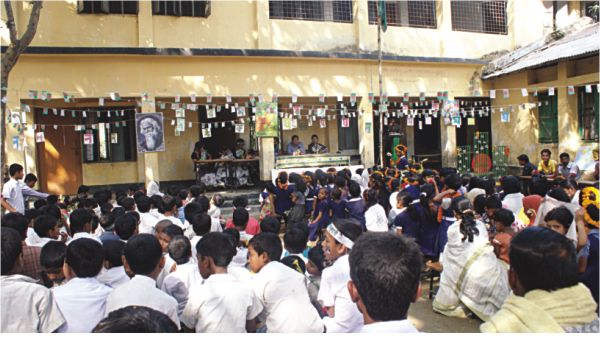Theatre
Learning from nature
Omar Rashid Chowdhury
On March 26, Bangladeshi Independence Day, students of Poorbo Lalpur village went out of their ways to explore nature and know about different kinds of soil and leaves. Far away from the maddening crowd of cities, in Chandpur, an initiative was taken, which propelled students towards education and creativity.
The educational project is working in four villages-- Lalpur, Kalipur, Bagan Bari and Putiar Par of Matlab Uttar thana. Five organisations took the initiative in 2003. The organisations are Onushondhitshu, the magazine Bakalam, Apsuk blood donation society, Practical Academy- an informal school for young learners and Shopno Co-operative Society. With 700 participants, ranging from third grade to post-graduate, the motto of this initiative is Amader gram, amrai sajai- Our village, our responsibility. All participants are from low-income families with agricultural backgrounds.

Celebrating and learning in an interactive manner.
Courtyard cultural programmes were also arranged, where local people participated. Hundreds of students joined the probhat feree- mourning march and other cultural functions. Janasadan - People's Home, a hub of activities relating to environment, education, science, health etc was also inaugurated on the same day.
There were different competitions too. Winners got agricultural products as prizes in competitions. The goal was to encourage ecological agriculture and preservation of natural resources.
Rural students, whose world once was limited to text books only, are now organising libraries in their homes. They are participating in extra-curricular activities, competitions and programmes arranged by the initiative, learning about science and the use of dictionary.
| |
 |
| |
A young participant at the programme.
|
There have been guests who graced many events of the project in the past. Professor Ali Asgar of the Department of Physics in East West University conducted discussions on science in Kaalipur in 2010. Astrophysicist Dr Deepen Vattacharya of the University of California, Riverside, also visited a plant nursery organised by the initiative in 2007. Education and cultural fairs, cultural competitions and programmes are held by the initiative on important national days. Students and local people enthusiastically participate in these programmes.
Apart from these programmes, walkathons are arranged annually, where people walk and cover scores of kilometers in the villages. Participants closely observe agro-life and nature and disseminate information related to health, nutrition, etc.
The funds for the programme comprise of contributions by local people of the locality. There is no private sponsorship. It is only people's money spent for people's cause. The organisers try and utilise local resources and minimise expenditure for the programmes. All financial accounts and transactions of the initiative are kept transparent and open to all. Anyone has the right to inspect the accounts and raise question. After every programme, the income-expenditure accounts are made public.
However, there is a low availability of teachers. Teachers are not usually willing to work in remote villages. Nonetheless, the initiative is trying to make a difference by taking small steps. The people of the villages are participating and bringing about changes through education and cultural activities in these four villages.
(The writer is a student of Civil Engineering, BUET)
DID YOU KNOW?
Shouryya Ray
 |
|
A 16-year-old mathematical whiz has discovered how exactly to calculate the path of a projectile under gravity and subject to air resistance--a dilemma first proposed by Sir Isaac Newton some 300 years ago. Born in India, Shouryya Ray says he came up with the solution while working on a school project, and has since received research awards and even been labeled a “genius” by the German media. Humble and brilliant, Ray wrote off the praise as “curiosity and schoolboy naivety.” The family moved to Germany when Ray was twelve and his father had reportedly been teaching him calculus since the age of six. According to the father, however, his son's aptitude soon surpassed his own knowledge, despite his training in engineering. Ray still credits his father with instilling in him a “hunger for mathematics.” When explaining why he chose to tackle Newton's problem, Ray simply said: “When it was explained to us that the problems had no solutions, I thought to myself, 'well, there's no harm in trying.'” While mathematicians have been able to surmise partial answers until this point, Fox News is saying that Ray's contribution will likely lead to greater precision in the field of ballistics, among others. Though Ray did not speak a word of German before arriving in the country at age twelve, he is due to graduate this week, two years ahead of his peers. When asked if there was anything he could not do, or wishes he could do better, Ray responded: “Football, for one.”
Information Source: Internet.
| 